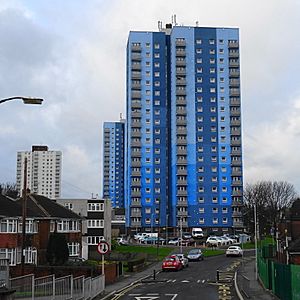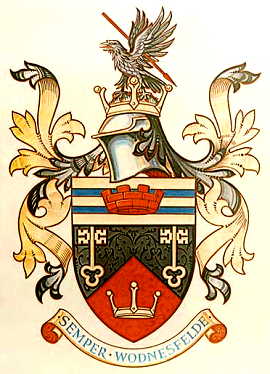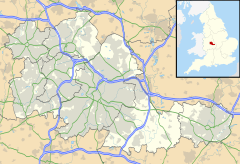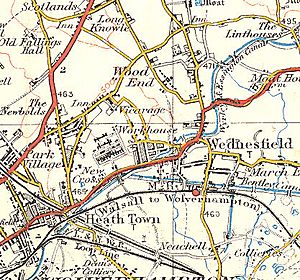Wednesfield facts for kids
Quick facts for kids Wednesfield |
|
|---|---|
 High-rises in Wednesfield, seen from Graiseley Lane. |
|
| Population | 22,646 (2011 Census Wards) |
| OS grid reference | SO944998 |
| Metropolitan borough | |
| Metropolitan county | |
| Region | |
| Country | England |
| Sovereign state | United Kingdom |
| Post town | Wolverhampton |
| Postcode district | WV11 |
| Dialling code | 01902 |
| Police | West Midlands |
| Fire | West Midlands |
| Ambulance | West Midlands |
| EU Parliament | West Midlands |
| UK Parliament |
|
Wednesfield is a town and old village in the City of Wolverhampton, England. It's about 2 miles (3.2 km) east of Wolverhampton city centre. It's also about 10 miles (16 km) from Birmingham. Wednesfield is part of the larger West Midlands conurbation, which is a big group of towns and cities. It used to be in the county of Staffordshire.
The name "Wednesfield" comes from an old English word, Wōdnesfeld. This means "Woden's Field," referring to open land that belonged to or was special to Woden, a high god in old Germanic mythology. People who live there often say the name as "Wedgefield."
Some local areas nearby include Ashmore Park and Wood End. There's also a nice garden at Wednesfield Park.
Contents
Exploring Wednesfield's Location
Wednesfield is located in the northeast part of Wolverhampton. It sits on the edge of the West Midlands conurbation. Historically, it was part of Staffordshire. Since 1974, it has been part of the West Midlands metropolitan county, which is a large urban area.
The land in Wednesfield is mostly flat. It's about 130 to 140 metres above sea level. In the north, it rises a bit higher, to around 170 metres. The southern part of the town is on top of coal deposits. The town centre has a type of rock called dolerite. The northern area is on mudstone and sandstone.
There are no big rivers that boats can use in Wednesfield. However, the original path of the River Tame used to cross the southeast part of the town.
How Wednesfield is Governed

In the past, Wednesfield had different ways of being governed. In 1834, it became part of the Wolverhampton Poor Law Union. This group helped provide support for people in need. Before that, the area had its own workhouse since 1723.
Later, in 1863, the Wednesfield Local Board of Health was created. This group was in charge of keeping the town clean and healthy. It replaced an earlier committee that started in 1856. This board only lasted three years before it split into two parts: one for Wednesfield and one for Wednesfield Heath.
After 1894, Wednesfield (without Wednesfield Heath and part of Short Heath) became an urban district. This meant it was a self-governing area within Staffordshire.
In 1966, most of Wednesfield Urban District joined the County Borough of Wolverhampton. Some smaller parts went to Walsall and Cannock Rural District. This change happened because of a law passed in 1958.
In the early 1950s, when Wednesfield was still separate from Wolverhampton, Wolverhampton council built two new housing areas in Wednesfield. These were Ashmore Park and Long Knowle. They were built to rehouse families from crowded areas in Wolverhampton.
Today, for local elections, Wednesfield is divided into areas called wards. These are Wednesfield North, Wednesfield South, and Fallings Park. Together, they form the Wednesfield and Fallings Park Local Area.
Wednesfield is part of the Wolverhampton North East constituency. This means it has a representative in the UK Parliament. The current representative is Jane Stevenson, who is a member of the Conservative Party. She was elected in 2019.
Wednesfield's Past
A very important event in Wednesfield's history happened on August 5, 910. The armies of Mercia and Wessex (two old English kingdoms) fought against Northumbrian Vikings. This battle is known as the Battle of Tettenhall. It is sometimes also called the Battle of Wednesfield or Wōdnesfeld. The English forces won this battle.
Wednesfield used to be famous for making all sorts of traps. This included everything from mousetraps to larger mantraps, and also locks. Many of the old factories that were once busy with this work have now been replaced by houses and other buildings.
| Historical population of Wednesfield | ||||||||||||||||||
| Year | 1801 | 1811 | 1821 | 1831 | 1841 | 1851 | 1861 | 1871 | 1881 | 1891 | 1901 | 1911 | 1921 | 1931 | 1939 | 1951 | 1961 | 2001 |
|---|---|---|---|---|---|---|---|---|---|---|---|---|---|---|---|---|---|---|
| Population | 1,088 | 1,248 | 1,468 | 1,879 | 3,168 | 4,858 | 8,553 | 8,998 | 10,801 | 14,538 | 4,883 | 6,488 | 7,446 | 9,330 | 14,894 | 17,418 | 33,048 | 33,555 |
| Township 1801–1891 • Urban District 1901–1961 • LANA 2001 | ||||||||||||||||||
Places of Worship
The Church of St Thomas is in the town centre. It was first opened in August 1750. At that time, it was a smaller church connected to St. Peter's Collegiate Church in Wolverhampton. It became its own separate church parish in 1849.
Sadly, a fire almost completely destroyed the church on January 18, 1902. Because of this, only the tower is left from the original building. The church was rebuilt to look very similar to the first one. It is still used actively for worship today.
The Guru Nanak Gurdwara is also in the town centre. It opened in 1984 and serves the local Sikh community. Many of these community members are descendants of people who moved to the area from the 1950s onwards. Part of the Gurdwara was damaged by fire in 2002. The community decided to knock down the old building and rebuild it. The new building was ready by 2004. It has lifts to help elderly people.
Wednesfield's Economy
Wednesfield Village, or "the village" as many locals still call it, has many shops, offices, and community places. These serve people living in the northeast of Wolverhampton and some nearby parts of Metropolitan Borough of Walsall. It also provides services for the large industrial areas south of the town and New Cross Hospital.
Just west of the town centre, there is a big Sainsbury's supermarket. There is also the Bentley Bridge Retail Park. You can also find a retail market in the town.
Bentley Bridge has both fun activities and shops. For fun, there's a multiplex cinema and a bowling alley. There are also fast-food places, a pub, and many restaurants. For shopping, there's a large area with stores, including a fitness gym.
Being close to Wolverhampton city centre has made it a bit harder for shops in Wednesfield to grow. Wednesfield is one of several smaller town centres in the Black Country. These centres mostly provide everyday shopping for local people. Other similar centres nearby include Bilston to the south, Willenhall to the southeast, and Bloxwich to the east.
However, since 2009, the Bentley Bridge Retail Park has been doing very well. Empty shops have been filled by big national stores. For example, in September 2011, TK Maxx moved its city centre store from Wolverhampton to Bentley Bridge. While the retail park is doing great, smaller local shops on the high street still face challenges.
The area south of the old railway line is mostly industrial. It has many small businesses. There are also some larger ones, like a steel processing and distribution plant. In the past, the main jobs were coal mining and trap making. However, coal mining stopped in the area in the early 1900s.
Getting Around Wednesfield
The Wyrley and Essington Canal runs through Wednesfield. It opened in 1797. This canal was built to move coal from mines near Great Wyrley to Wolverhampton. It followed the natural shape of the land. This meant the town centre was surrounded by the canal on three sides. Almost all the old roads needed hump-backed bridges to cross it. Even though the canal helped with transport, some local people felt it actually stopped the town from growing.
A second canal, the Bentley Canal, opened in 1843. It ran between Wednesfield Junction (near the modern New Cross Hospital) and Walsall. This canal was closed in the 1960s. Only a small part of it is still there at Wednesfield Junction.
The Wednesfield railway station opened in 1872. It was on the Wolverhampton and Walsall Railway. This connected Wednesfield to Wolverhampton High Level and Walsall. The station closed to passengers in 1931 but stayed open for goods until the 1980s. A lot of the old railway path was used to build the A4124 Wednesfield Way. This road goes around the town centre and opened in 1999.
The very first railway in the area was the Grand Junction Railway. Its station, Wednesfield Heath railway station, opened in 1837. This was the main station for Wolverhampton at the time. It closed to passengers in 1873 but stayed open for goods until 1965. The location of this station is thought to be one reason why Wednesfield and Heath Town became separate places.
Public transport in Wednesfield is managed by Transport for West Midlands. Most bus services are run by National Express West Midlands. Buses from the town centre go to places like Wolverhampton city centre, Bilston, Bloxwich, Walsall, and Willenhall. The 59 bus route is the busiest in the city. It goes from Wolverhampton city centre to Ashmore Park, passing New Cross Hospital and Wednesfield High Street. The 71 bus route goes to Essington, Great Wyrley, and Cannock once an hour. Another service, the 65, runs hourly between Wolverhampton and Fordhouses.
There are plans to extend the West Midlands Metro (a tram system) through Wednesfield. This route, called the "5Ws" route, would connect Wolverhampton to Wednesbury via Willenhall and Walsall.
Famous People from Wednesfield
- Tom Aspaul – A singer, songwriter, and producer.
- Ruth Badger – A businesswoman who was a runner-up on the TV show The Apprentice.
- Martin Cooper – An England rugby union player.
- John Cosnett – A darts player.
- Wayne Jones – Another darts player.
- Jonathan Pedley − A Master of Wine.
- Hayley Price – An Olympic gymnast.
- Roy Rickhuss − A leader of a trade union.
- Kevin Rowland – A musician and the lead singer of Dexys Midnight Runners.
- Dion Sanderson – A footballer who plays for Cardiff City.
- Tessa Sanderson – An athlete and Olympic gold medallist.
- Kristian Thomas – An Olympic gymnast.
- Mary Whitehouse – A campaigner for cleaner TV and radio. She was a teacher at Lichfield Road School in the town from 1932 to 1940.



